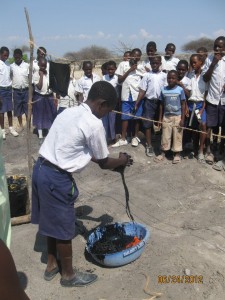Here in rural Tanzania, I have been been doing various jobs with Wildlife Connection. I have helped show villagers how to erect chili pepper and bee hive fences to keep elephants out of their crops. (Such simple technology and so effective!) I have helped teach eager children about wildlife and conservation issues. And I have assisted with trips into Ruaha National Park, escorting villagers into the park in our Land Rover, and then interviewing them about their perceptions afterward. But yesterday I took part in my first elephant corridor mapping trip, which, as with all other duties here, was an interesting adventure.
The morning started with our customary walk from our tented camp into the town of Tungamalenga for mandazi (doughnuts, sort of) and chai (spicey, sweetened tea). The other volunteers and I arrived back at camp just as our wonderful local assistant, Julius, pulled up on his pikipiki (motorcycle) ready to take me off to the elephant migration route or “corridor”. After jovial greetings I hopped on the back of the red pikipiki and off we went down the dirt road, engulfed in the smell of cook fires, the sounds of roosters crowing and hornbills calling, and the sights of farmers and villagers slowly starting their mornings in fields and shops.
After twenty minutes along the road and a narrow trail, we arrived at a mud farmhouse where we parked the pikipiki. The lady of the house (an effective witch doctor, per Julius) was seated outside on the ground, shelling peanuts from her farm. She offered me a handful, which I eagerly accepted and stuffed into the pocket of my cargo pants. We set off walking through farm lands until we got to a spot where we could make out a specific trail leading away form the farms: the end point of the elephant corridor. This is the trail that elephants make from Ruaha National Park and the adjacent Wildlife Management Area (WMA) out to fresh feeding areas in the rainy season, Their dispersal gives the elephants’ dry season feeding areas a chance to recover and regrow. But now that migration corridors are heavily populated with farmers, it means that conflict occurs here, as elephants passing through the plots trample or eat the crops that farmers depend on for food and income. The rainy season ended two months ago, and crops, including corn, rice and peanuts, have been harvested. Now even the river where elephants came to drink is dry, its rocky bed filled only with dust and cattle tracks and dung. And the elephants have, for the most part, returned to the protected areas, leaving the farms to the farmers.
We turned on our GPS units and began out trek along the elephants’ trail, which Julius’ trained eye picked out without hesitation. (I would have been completely lost!) We passed from the farm zone to the pastoralist zone, where agricultural plots were replaced by grazing areas for goats,sheep and cattle that wander in search or food, under the watchful eye of Maasai herders. We spotted two-month old signs of elephants’ presence, including dried mud “bowls”created by elephants’ enormous oval feet. We also saw larger dried mud scoops, created by elephants digging with their trunks in search of water. Softer sandy holes indicated dustbath sites. Dung balls from this year and last were scattered across the trail. An exciting discovery was a recent elephant print, with foot wrinkle lines still evident in the track. One to three days old! We found several others further on. I wondered where the elephant was now…
Other interesting finds were holes at the base of trees where, according to Julius, people had dug in search of medicinal roots. We found a large pelvis bone of an unidentified animal, and later two long giraffe leg bones. Julius said that the giraffe had probably been caught in a wire trap and then killed by people for bush meat. All local hunting of wildlife is illegal, but it can be difficult to apprehend poachers, so poaching continues. We saw fire remnants from poachers’ camps closer to the WMA, where poachers probably spent the night before going in to hunt animals the next day.
After our brisk 1 1/2 hour walk we reached the WMA and the unified elephant trail separated into many trails, since this was a safe zone for the elephants, and they could disperse and browse leisurely. We turned off our GPS units as the corridor was now mapped. I was happy for a rest in the shade, with water and peanuts to revive me, before we made the return trip.
The variety of interesting knobby, thorny, and cactus-like trees kept me going on the return as I tired out some. We were also treated to views of tiny dikdik and several majestic greater kudu in the bush. Nice fresh prints of dikdik, kudu, and impala were delicately engraved in the dust of the trail. We also observed scat from various animals, including giraffes and zebras. A large cylinder on the trail turned out to be a 16 inch hunk of dried elephant skin, a remnant from an elephant killed and cut into pieces for food.
I was relieved to reach the farmhouse where we had started our adventure and be able to rest my weary legs while sitting on the the back of the pikipiki again. As we took off, a lovely group of a dozen banded mongeese escorted us down the trail. We headed back to town and a welcome filling lunch of rice, beans and cooked greens at Fatuma’s screen-porch restaurant. It had been another day full of learning and fun in the Tanzanian countryside!
– Helen



